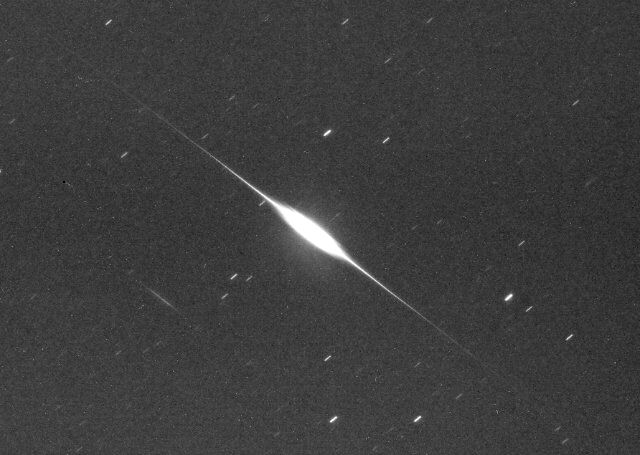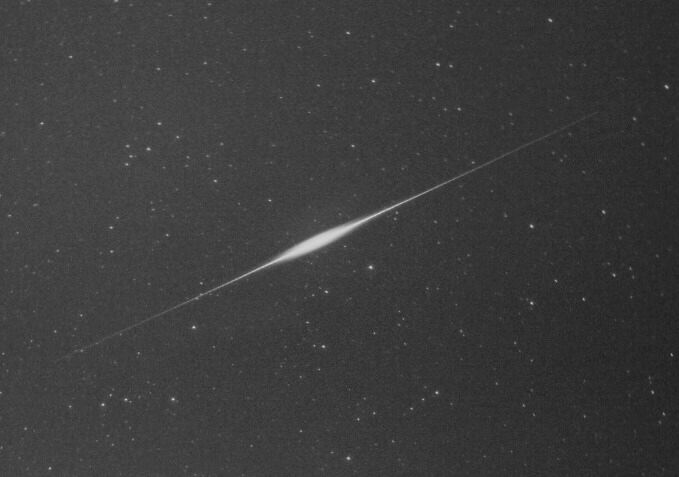
 The observation and imaging of Iridium flares has become something of a cult. Iridium satellites' sole purpose is to
assist in global communications (digitized phone calls, wireless electronic mail etc) and number 66 in total now that
current orbiting plans are complete where eleven satellites have been allocated to six equally-spaced orbital planes
covering the entire surface of our planet (original plans called for eleven satellites across seven orbital planes and,
hence, for the name Iridium which represents the 77th element of the periodic table).
The observation and imaging of Iridium flares has become something of a cult. Iridium satellites' sole purpose is to
assist in global communications (digitized phone calls, wireless electronic mail etc) and number 66 in total now that
current orbiting plans are complete where eleven satellites have been allocated to six equally-spaced orbital planes
covering the entire surface of our planet (original plans called for eleven satellites across seven orbital planes and,
hence, for the name Iridium which represents the 77th element of the periodic table).
These satellites are placed in "LEO" (low-earth orbit) and completely circle the planet every 100 minutes or
approximately 14.34 times per day. Iridium flares represent the unique occurrence in space and time where the panels of
the satellite perfectly redirect the solar or lunar light onto an observer on the planet's surface. Aside from the
silhouette images that one can capture during a solar or lunar transit, Iridium flares represent the only other means by
which a ground-based observer can detect or observe a satellite during the day. With a peak magnitude of about -8.4,
these flares can easily compete with a well-developed crescent moon during darkness and can be quite visible during the
day as well.
Although one may see references to Iridium satellites with an ID greater than 66, for approximately 87 such satellites
have been launched to date and are currently in orbit, the ultimate number of functional satellites still remains at 66
Iridiums. The excess represent back-ups (ex Iridium 14, 20, 21), various failed missions (ex Iridium 9, 27 and 44) and
some still not in their proposed operational latitude (ex. Iridium 77, 82 and 86). With such a rich number of Iridium
satellites available for photography, it is not unusual for one to have a local flare during any particular evening with
a magnitude of -0 or better (the intrinsic magnitude of these satellites is approximately +6). Personally, for
photographical purposes, I concentrate on those flares whose magnitude will be at -4 or greater.
The tools required for Iridium satellite flare photography are rudimentary. Aside from a camera capable of a "B" (bulb)
exposure setting (preferably with a mechanical shutter release so as not to consume battery power during extended
exposures), you will also need a secure tripod, a shutter release cable, a 50 mm and/or 100 mm lens as well as an
accurate timing device such as a watch or cellular phone which will be synchronized to a time-server providing Atomic
time.
Iridium flares usually range in duration from 2 to 30 seconds but can last up to 45 seconds. Equally important is the
area of the sky where the flare is to be observed and/or imaged with azimuth, in lieu of altitude, invariably being the
dimension which will exhibit the greatest variation.
When planning to image a flare, my modus operandi is as follows:
| Step 1: | I will ping to a time server operated by the US National Institute of Standards and Technology (NIST) using Atomic Clock Sync V2.0 (freeware from http://www.worldtimeserver.com/) for the calibration of my cellular phone to the atomic time-scale operated by NIST so as to be accurate to within +/- 0.5 seconds and, thereby, know the precise second to trip the shutter release cable. | |||
| Step 2: | Download two-line orbital elements 60 minutes before the predicted flaring so as to have the most accurate orbital information possible and, hence, be in a position to predict the start of the flare down to the actual second. | |||
| Step 3: | Analyze the projected path of the Iridium satellite during the flare so as to extract the range in both azimuth and altitude. The former usually ranges from 3 to 13 degrees whereas the latter usually ranges from 1 to 4 degrees. With this information now at hand, I am able to identify the best focal length lens to use between my 50 (or 55) mm, 100 mm and 200mm lenses whose fields of view are 25°x37°, 14°x21° and 7°x10°, respectively (keeping in mind that I want the flare to cover one-half to two-thirds of my field of view and image). | |||
| Step 4: | Another consideration is the length of exposure. Aside from the length of the flare itself - usually between 2 and 30 seconds - I will start the exposure 3 seconds prior to the predicted start of flaring in the event of a slight error in the predicted start time, the calibration of my cellular phone using the NIST time-servers or anything else that I may have failed to consider (age of TLE's etc). The end of the exposure, of course, is usually dictated by the end of the flare itself. | |||
| Step 5: | Final comment in relation to the exposure itself is the altitude of the flare as it will dictate whether star trails will be captured in the image or not. If the flare is sufficiently high and the lens being used is of short focal length, longer exposures and without star trails are possible. As a result, I can keep the shutter open for up to 10 seconds longer in spite of the fact that the flare has come to an end so as to capture additional pinpoint images of stars (and/or a constellation) in the image. For example, using a 50 mm lens to image a flare at an altitude of 60°, I can keep the shutter open for up to 52 seconds prior to star trails becoming a factor. For the same lens but with a flare at 45° and 30°, respectively, the associated maxima are 37 and 31 seconds. This extra "exposure" should be ignored if sky glow is present (usually the case with Iridium flares at 20-25 degrees altitude and less). |
| TABLE 1: Excellent web sources for two-line-orbital elements | ||||
|---|---|---|---|---|
| Item | Owner | URL | Mode | Comments |
| Tom Kelso | http://ftp.celestrak.com | Updated twice during the day | ||
| Mike McCant | http://users2.ev1.net/~mmccants/tles/index.html | TLE's for up to 8000 satellites including classified sats |
||
| NASA US Space Command | http://oig1.gsfc.nasa.gov/files/filename.tle | Browser d/l | Download specific files individually (iridium.tle etc) |
|
Once the above orbital elements have been downloaded and processed locally, there exist a number of software tools
available for generating flare predictions and trajectories. Aside from Chris Peat's excellent Heavens-Above site
(http://www.heavens-above.com) which provides the user with the flare peak time - not sufficient for our purposes as we need
the flare start time as well - for his/her geographical location and which does not require any effort from the user in
the collection and processing of TLE's, Robert Matson's IridFlar V2.1 and SkyMap V6.4 do a masterful job in generating
flare predictions for any location on earth and for any user-selected interval into the future with reports providing a
wealth of information relating to each predicted flare. SkyMap will also produce highly accurate plots of the trajectory
with magnitude estimates at user-specified time intervals during the overhead pass and provide an estimate of the
distance to the flare center so as to observe the flare at its maximum possible magnitude (a few kilometers distance
can influence the peak magnitude). Chris Marriott's SkyMap Pro V9 is also another piece of software that I have found
to do a very good job with flare predictions and the plotting of the associated trajectories.
 For planning purposes, I will generate flare predictions up to three weeks in advance so as to get a flavor of upcoming
flare magnitudes, particularly looking for those predictions which suggest flares at -6 magnitude or greater. For
Iridium satellites in stable orbit, such predictions into the future are quite stable as the flare times will change by
a few seconds at most once fresher two-line orbital elements are downloaded near the proposed date of flaring. For other
satellites, such as tumblers and those not yet in operational orbit, these long-term projections are quite unreliable and
require continuously updated TLE's.
For planning purposes, I will generate flare predictions up to three weeks in advance so as to get a flavor of upcoming
flare magnitudes, particularly looking for those predictions which suggest flares at -6 magnitude or greater. For
Iridium satellites in stable orbit, such predictions into the future are quite stable as the flare times will change by
a few seconds at most once fresher two-line orbital elements are downloaded near the proposed date of flaring. For other
satellites, such as tumblers and those not yet in operational orbit, these long-term projections are quite unreliable and
require continuously updated TLE's.
The astrophotographer's old nemesis, namely the moon, is quite often a challenging foe and should always be kept in
mind. Iridium flares with a predicted magnitude of -7, for example, can seem to be more like -2 and -3 when the moon is
nearby. Actual flare times up to 15 seconds earlier than predicted with a full moon in the near vicinity of the flare
are, regrettably, common.
If you are looking for a challenge, I suggest you consider four mini-projects. First, see if you can capture a daytime
flare. The best daytime flares (-6 magnitude and brighter) usually occur an hour or two after sunrise and/or two to
three hours before sunset. However, be warned that their duration is quite brief as they last for but a few seconds and
you must orient yourself during the day and without any reference stars! A second mini-project is the imaging of a
flare which transits the lunar surface. Although the extended exposure (based on the flare itself) will saturate the
image of the moon, a flare transiting the moon is very rare and has yet to be captured on film (the closest I have come
is Iridium 83 which missed the moon by one degree on July 26, 2001). The third mini-project is the imaging of a flare
from a tumbling Iridium satellite where the tumbling leads to an unpredictable rotation of the solar panels and the
observer is privy to a flare which seems to be flashing on and off and with varying intensity (i.e. magnitude). The
fourth and final mini-project is the imaging of a flare whose source of redirected light is the moon rather than the
sun. With a magnitude of slightly greater than -12, a full moon is theoretically a potential medium for the flaring
of an Iridium satellite and it is my understanding that this is also something that has yet to be captured.
Note: The above text is being submitted for publication.